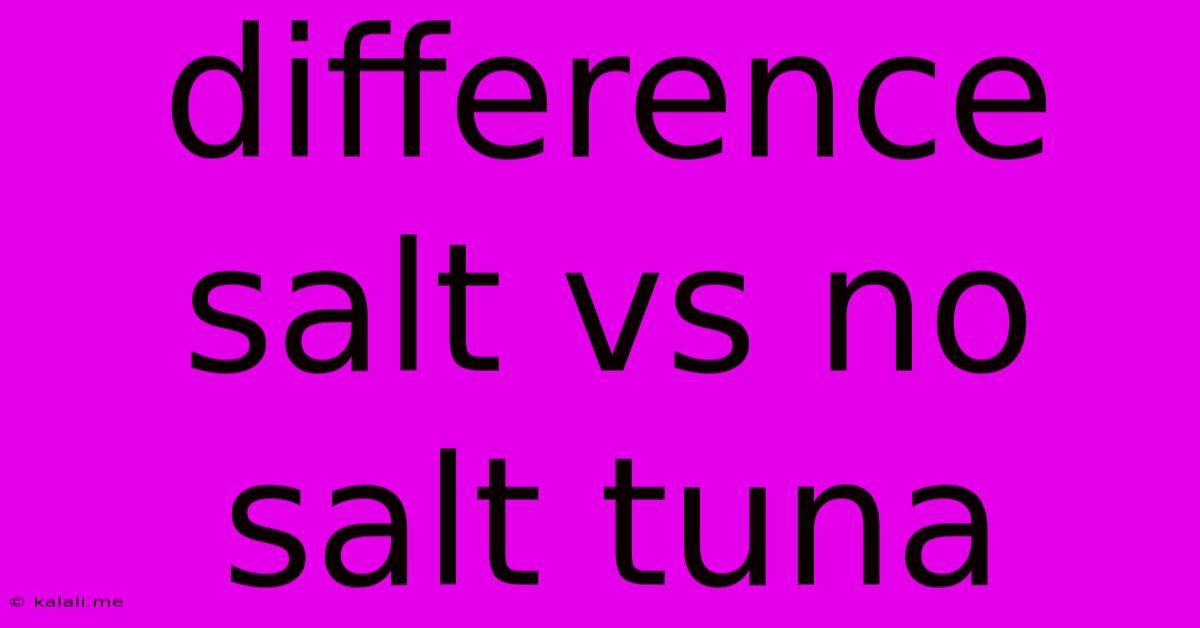Difference Salt Vs No Salt Tuna
Kalali
Jun 05, 2025 · 3 min read

Table of Contents
Salt vs. No Salt Tuna: What's the Difference and Which Should You Choose?
Choosing between canned tuna packed in salt versus tuna packed in water can seem insignificant, but understanding the differences can significantly impact your health and the flavor of your dishes. This article explores the key distinctions between salt and no-salt tuna, helping you make an informed decision for your culinary needs and dietary goals. This comparison considers factors like sodium content, taste, texture, and overall nutritional value, allowing you to choose the best option for your lifestyle.
Key Differences: Salt vs. No Salt Tuna
The most obvious difference lies in the sodium content. Tuna packed in water contains significantly less sodium compared to tuna packed in brine (saltwater). This is a crucial factor for individuals watching their sodium intake, particularly those with high blood pressure or other health conditions. Reducing sodium intake is often recommended to improve cardiovascular health.
Beyond sodium, the packing method subtly affects taste and texture:
-
Taste: Tuna packed in salt often has a slightly saltier and more pronounced flavor, while no-salt tuna retains a more natural, milder taste profile. This difference might influence your preference depending on the recipe. Some find the saltiness enhances the flavor of certain dishes, while others prefer the cleaner taste of no-salt tuna.
-
Texture: While not drastically different, some individuals note a slight textural variation. Tuna packed in brine might have a slightly firmer texture, whereas tuna packed in water can sometimes feel a bit softer.
Nutritional Comparison: A Closer Look
While the primary difference revolves around sodium, let's compare the broader nutritional profiles:
| Nutrient | Salt Tuna | No Salt Tuna |
|---|---|---|
| Sodium | High | Low |
| Protein | Similar levels in both | Similar levels in both |
| Omega-3 Fatty Acids | Similar levels in both | Similar levels in both |
| Vitamins (B vitamins) | Similar levels in both | Similar levels in both |
| Minerals (Potassium, Magnesium etc.) | Similar levels in both, may vary slightly depending on brand | Similar levels in both, may vary slightly depending on brand |
It's crucial to note that the overall nutritional content, including protein, omega-3 fatty acids, and vitamins, remains relatively consistent between both types. The key differentiator remains the sodium level.
Choosing the Right Tuna for You
The best type of tuna ultimately depends on your individual needs and preferences:
-
Choose No Salt Tuna if:
- You are watching your sodium intake.
- You prefer a milder, more natural taste in your dishes.
- You're preparing dishes where you want to control the salt level precisely.
-
Choose Salt Tuna if:
- You enjoy a saltier flavor profile.
- You’re using the tuna in recipes that benefit from added saltiness.
- Sodium content isn't a major concern for your diet.
Beyond Salt vs. No Salt: Other Considerations
Remember to consider other factors when buying canned tuna:
- Type of Tuna: Albacore (white) tuna is generally higher in fat and calories than skipjack (light) tuna.
- Sustainability: Look for tuna brands committed to sustainable fishing practices. Check for certifications like the Marine Stewardship Council (MSC) label.
- Ingredients: Opt for tuna packed in water or oil with minimal added ingredients.
By considering these factors, you can make a well-informed choice that caters to both your health needs and culinary preferences. Selecting the right tuna becomes an important step in creating delicious and nutritious meals.
Latest Posts
Latest Posts
-
Borderlands 2 Level Scaling Normal Mode
Jun 06, 2025
-
Best Sealer For Pressure Treated Wood
Jun 06, 2025
-
Kid Show With Boy With Blue Hair
Jun 06, 2025
-
Is Arduino A Microcontroller Or Microprocessor
Jun 06, 2025
-
What Does Passing Mean In Code
Jun 06, 2025
Related Post
Thank you for visiting our website which covers about Difference Salt Vs No Salt Tuna . We hope the information provided has been useful to you. Feel free to contact us if you have any questions or need further assistance. See you next time and don't miss to bookmark.